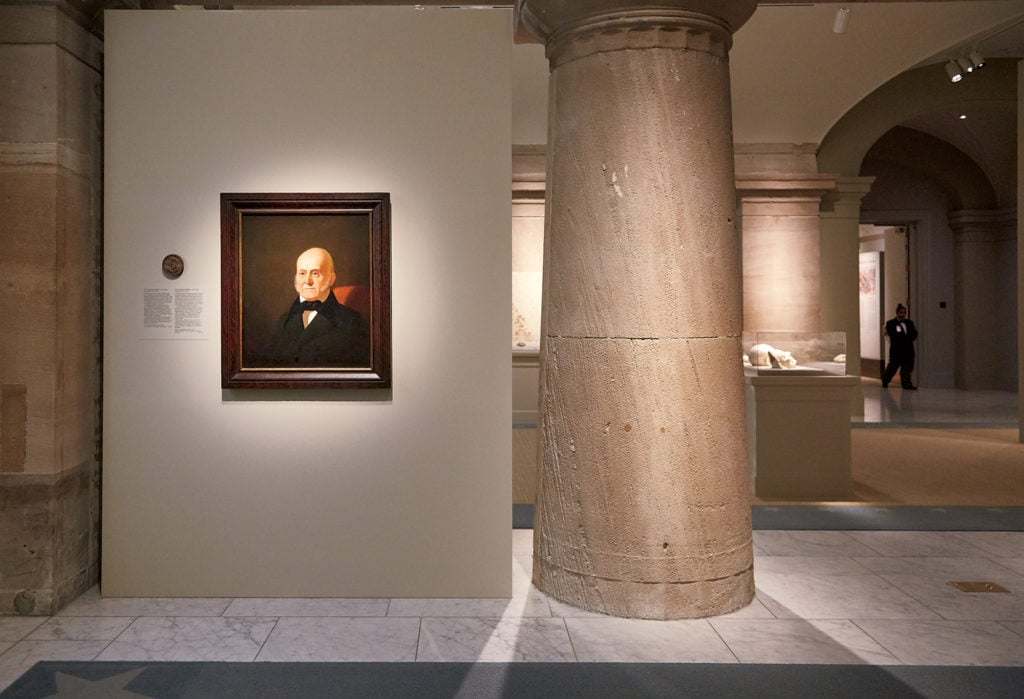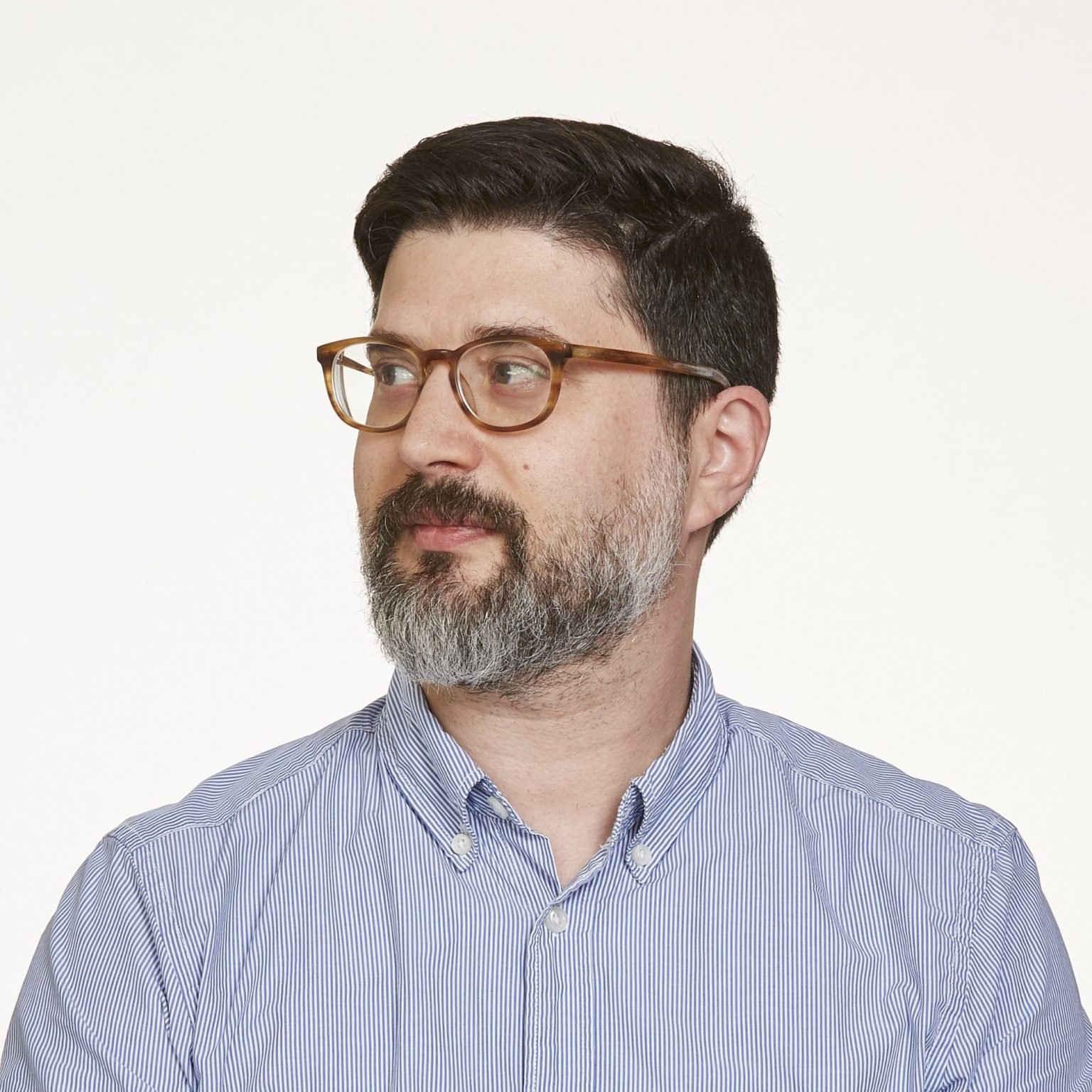Appropriate Pictures of John Q Adams Funny Pictures of John Q Adams
A museum conservator holds the 1843 Adams photograph. Photograph by Jeff Elkins
Antiques Roadshow premiered on PBS in 1997, and as the program grew into a hit, curators at the National Portrait Gallery started to notice an uptick in correspondence. The notes came from viewers who'd been digging around in their attics and come across things they believed would be perfect for America's attic. "If the man had a beard and wore a top hat, it's got to be Abraham Lincoln," says Ann Shumard, the Portrait Gallery's senior curator of photographs. "Ninety-nine times out of 100, it is wishful thinking."
In December 2016, Shumard got an e-mail that seemed different. A man had found a daguerreotype in a desk drawer at his parents' house after they died in 1991. He'd always figured it was probably his great-great-grandfather Horace Everett, a Vermont congressman from 1829 to the early 1840s. Interesting, he thought, but not hugely significant. Back into the drawer it went.
But about a decade ago, the man said, he'd started doing some research online, and the person in the image appeared to be John Quincy Adams. He thought it was probably just some kind of copy of a daguerreotype, but he was hoping for more info and names of appraisers. Shumard asked to take a look. When she saw the image, she got excited. She strongly suspected that this was no copy but rather an extremely rare original: the actual plate made by the photographer.
As it turned out, Shumard was right. And as the owner later learned, it was even more exciting than that. The little portrait in the desk drawer was actually the oldest existing original photograph of any American President. An appraiser said it was probably worth $250,000 to $300,000. He decided to sell it, and Sotheby's agreed to handle the auction. Excitement grew as word of the discovery spread.
But the owner remained fascinated by the mystery of the thing: What was the real story behind this ghostly image of a glowering old man? And how had it come to be hidden away for all those years in his parents' house? Before long, new research and old diaries helped piece the story together.
The morning of Thursday, March 16, 1843, was unusually frigid in Washington. John Quincy Adams had slept badly, and he couldn't have been thrilled to leave his three-story F Street home to walk down to Philip Haas's studio near the Capitol. But Adams had said he would come, so he put on his coat and wool-lined gloves and ventured out.
Daguerreotypes had been introduced just four years earlier, and the technology was still rare in America. Haas, a lithographer by trade, was an early adopter, and he had convinced the former President to give it a try. Adams had already posed for him once, just eight days before. But in that early era, the process often failed. After something went wrong during the sitting, he'd promised to return.
At the time, Adams was a big get. His undistinguished one-term presidency had ended in 1829, but by 1843, as he headed into his 13th year as a Massachusetts congressman, he had grown into one of America's most respected moral voices. Only two years before, Adams—who loathed slavery—had successfully argued in front of the Supreme Court on behalf of the African captives who had fought for their freedom on the Amistad.
When Adams arrived at Haas's shop that Thursday, he was surprised to find another subject already seated for a portrait: Horace Everett. Fortunately, Everett was a friend and colleague, and Adams stuck around to wait his turn. After completing one plate of Everett, Haas had Adams arrange himself stiffly in a chair next to a fireplace, then took three shots. The former President crossed his legs, clasped his hands, and stared straight into the camera. He didn't smile.
"The operation is performed in half a minute," Adams wrote in his diary, "but is yet altogether incomprehensible to me." His indifference to world-changing technology was surprising: Generally quite interested in scientific advancements, Adams sat on the congressional committee to oversee the creation of the Smithsonian, advocated for astronomical observatories, and even liked to spend time checking out new inventions at the US Patent Office. But for whatever reason, photography didn't much stimulate his curiosity.
Perhaps that explains why Adams would soon give away one of the morning's successful portraits. Or maybe it was chagrin at having interrupted his friend's session. Either way, sometime after receiving it, he wrapped a plate in brown paper, then wrote out the address by hand: "Hon Horace Everett/Windsor/Vermont." For the return address, he simply put "JQ Adams." Everett's descendants held onto it for 174 years.

When Haas was done with his work that day, Adams headed to the Capitol down the street. "I made my way home through the snow," he wrote, "which continued to fall the whole day through. More than has fallen at one time for many years."
Adams died five years later. Haas moved to New York in 1844, and his studio was torn down long ago. Today the spot—identified in the 1843 Washington City directory as the north side of Pennsylvania Avenue, between First and Second streets, Northwest—is a strangely desolate strip, a two-block-long grass triangle adjacent to the Capitol grounds. The location is marked only by a single scraggly cherry tree.
The Patent Office that Adams sometimes visited was located in an imposing Greek-revival edifice on F Street, about halfway between his home and Haas's studio. The building is still there, but these days it's home to a different institution: the National Portrait Gallery.
One recent winter afternoon, senior curator of photographs Ann Shumard met up with photo conservator Christina Finlayson in the conservation lab on the museum's third floor. Finlayson tugged on some bright-purple gloves, pulled open a drawer, and delicately placed its contents on a nearby work table. Suddenly, there it was: the Adams daguerreotype.
The photo wasn't much bigger than an index card, which made it relatively large by daguerreotype standards. The image was hard to see in direct light, but when held at an angle and shielded from the overhead fluorescents, it revealed Adams's gruff visage, staring out from the same copper plate that Haas had handled.
From the moment she first heard about the picture, Shumard had wanted it for the museum's collection. The historical value was obvious, of course, and though a slightly different Haas picture of Adams hangs in New York's Metropolitan Museum of Art, that one is a copy of the actual plate, which has been lost.
But the photo isn't just a piece of history—it's also strangely compelling to look at. More than the paintings of Adams from that era, it seems to document something essential about the man: the intimidating dignity that made such an impression on fellow politicians and the American public. "He was not a warm person—he terrified his own children," says James Traub, author of the 2016 biography John Quincy Adams: Militant Spirit. "I think what you see in that photograph is a very unyielding person, but a person of great integrity and austerity."
On October 5, Sotheby's held an auction of important photographs, including works by Ansel Adams and Edward Weston. The Haas daguerreotype was the one of the sale's centerpieces.
Shumard anxiously followed the bidding online. There was a limit to how much the museum could spend. (The museum had raised money from Smithsonian funds and private donors.) She was worried about deep-pocketed private collectors. But after just a few minutes, it was over. It had sold for $360,500, and the Portrait Gallery had won. "There was just complete elation," Shumard says. "Everyone here had so much emotionally invested in this."
On February 7, the daguerreotype will go on display as part of the museum's recently revamped "America's Presidents" exhibit. Housed in a special case that will make it easier to see, the image will sit next to a George Caleb Bingham oil painting of Adams, not far from Gilbert Stuart's famous "Lansdowne" portrait of George Washington. "America's Presidents," which includes at least one work depicting each past commander in chief, is the National Portrait Gallery's most popular attraction. Thousands of visitors will now be able to gaze into Haas's small metallic rectangle and travel, for a moment, back to that freezing Thursday morning in 1843.
The photo is in surprisingly good shape, given that it was never professionally cared for. In the conservation lab, Finlayson explained that there wasn't much to do to prepare it for exhibition. The frame would be sent to an expert for some repairs, and there was a thin black border around the image that she had to remove. She had already carefully removed the handwritten mailing label on the back, which will be preserved and put into storage. Otherwise, it was pretty much ready to go.
After Finlayson finished with the photo, she carefully lifted it off the table, getting ready to put it back in its temporary home. She gave Haas's handiwork a quick last look. "It's pretty magical," she said, then slid it back into the drawer.
This article appears in the February 2018 issue of Washingtonian.
Source: https://www.washingtonian.com/2018/02/02/how-an-ultra-rare-photo-of-john-quincy-adams-went-from-a-desk-drawer-to-the-national-portrait-gallery/

0 Response to "Appropriate Pictures of John Q Adams Funny Pictures of John Q Adams"
Postar um comentário